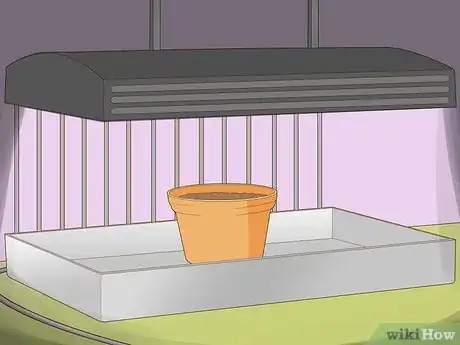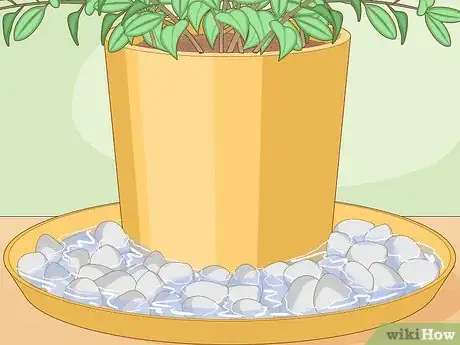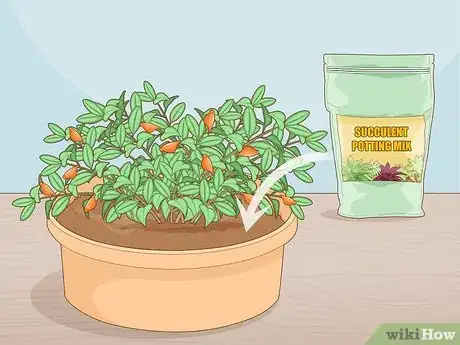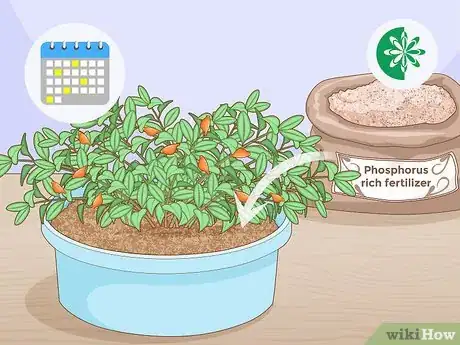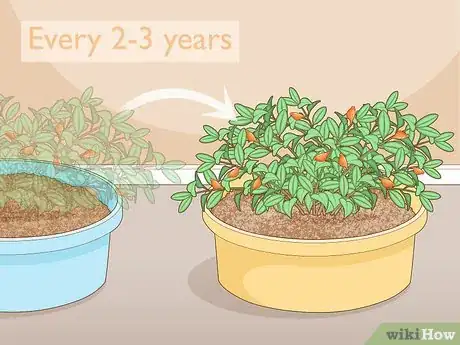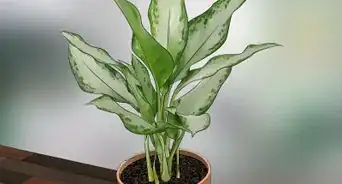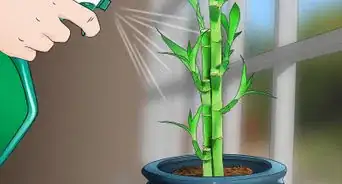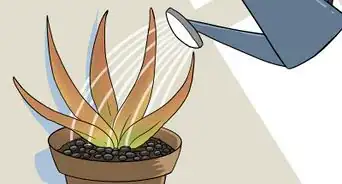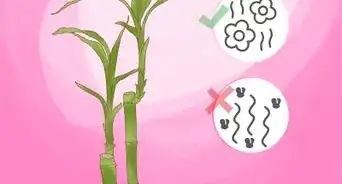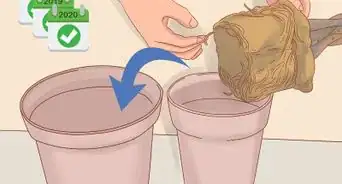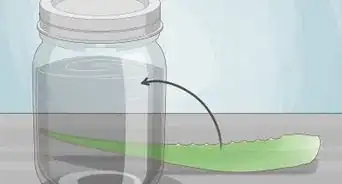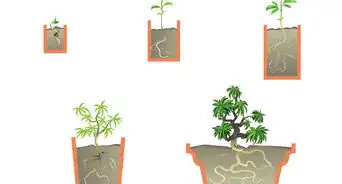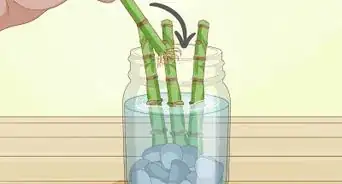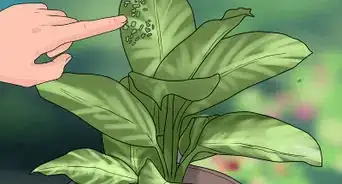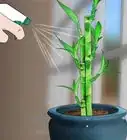This article was co-authored by Ryan Glynn, CPA and by wikiHow staff writer, Megaera Lorenz, PhD. Ryan Glynn is a Plant Specialist, Interiorscaper, and the Founder of Chicago Plants, LLC. He specializes in houseplant care, interior plant-scaping, and gardening. Ryan and Chicago Plants have been featured in several media outlets such as TimeOut Magazine and the Chicago Tribune. Ryan holds a BBA and Master’s degree in Accounting from The University of Wisconsin-Madison.
wikiHow marks an article as reader-approved once it receives enough positive feedback. In this case, 95% of readers who voted found the article helpful, earning it our reader-approved status.
This article has been viewed 215,878 times.
The goldfish plant, or Columnea gloriosa, is a trailing plant with attractive, dark green leaves and red flowers that resemble leaping fish. These pretty plants are native to the rainforests and tropical regions of the Americas. They make excellent houseplants and grow well in hanging baskets and planters. To care for your goldfish plant, keep it in a warm, humid place with plenty of indirect sunlight.
Steps
Creating the Best Growing Conditions
-
1Pick a spot with indirect sunlight. Goldfish plants need lots of light, but direct sunlight will cause the leaves to burn.[1] If you’re growing your plant indoors, place it in a window that faces north or east to prevent it from getting too much light during the day.[2]
- These plants can also do well under an artificial grow light.
-
2Plant your goldfish plant in a humid area. These plants love humid conditions.[3] To make sure your goldfish plant gets the humidity it needs, place the pot on a shallow tray or saucer with pebbles in it and pour a little water into the tray. The water will evaporate and create moisture for the plant.[4]
- Don’t put in so much water that it touches the bottom of the pot. This could cause the soil to become soggy.
- If your plant is in a hanging basket, you can instead mist it every day with lukewarm water. Don’t use cold water, since this will damage the leaves.
Tip: Another way to create a humid environment for your plant is to keep it in a bathroom, where it can get plenty of steam from the shower.[5]
Advertisement -
3Maintain a temperature of around 65–75 °F (18–24 °C). Goldfish plants do well in warm conditions, but they are sensitive to heat and cold. Keep your plant in a temperature-controlled area so that it doesn’t get too hot or cold.[6]
- If you notice the leaves of your goldfish plant turning brown or falling off, it may mean that your plant is too hot.[7]
-
4Put the plant in a wide planter so it can trail. In nature, the goldfish plant is epiphytic, meaning it usually grows in trees rather than on the ground.[8] For this reason, it’s easiest to grow goldfish plants in planters or hanging baskets rather than in your garden. Choose a pot that is at least 6–8 inches (15–20 cm) wide to allow your plant to trail and spread out.
- Make sure to choose a planter with good drainage, since soggy soil can cause the roots to rot.[9]
-
5Give your plant a well-draining potting mix. It’s important to keep epiphytic plants in soil that drains well, since waterlogging can cause the plant to rot. Choose a soil that won’t retain too much water and allow your goldfish plant to become soggy.[10]
- An orchid or succulent potting mix containing perlite and peat moss should work well.
Maintaining Your Goldfish Plant
-
1Water your plant often enough to keep the soil moist. To keep your goldfish plant well-watered but not soggy, water it any time you notice the soil becoming dry.[11] The soil should feel moist, but not waterlogged.[12]
- You will not need to water your goldfish plant as often during the winter as during the summer. However, water it often enough that the soil never completely dries out.
-
2Fertilize your plant once a week in the growing season. During the spring through early fall, give your goldfish plant a phosphorous-rich fertilizer once a week to encourage blooming. Don’t fertilize the plant during the winter.[13]
- Choose a water-soluble fertilizer and follow the instructions on the package.
-
3Repot the goldfish plant every 2-3 years. Goldfish plants thrive and produce better blooms if you repot them every few years. Remove your plant from its pot and replant it in a clean, slightly larger pot with fresh potting soil.[14]
- When you repot the plant, trim the ends of the roots slightly to encourage new root growth.
-
4Keep the stems trimmed to 12–18 inches (30–46 cm) in length. Regular pruning will encourage healthy branching and keep your plant looking its best. Pinch off the tips of the stems regularly and trim back any branches that are starting to look too long or “leggy.”[15]
- In addition to trimming the branches, regularly deadheading wilted blossoms can encourage the plant to produce more blooms.[16]
-
5Fight off pests with an insecticidal soap spray. Goldfish plants are susceptible to a variety of pests, such as aphids, spider mites, and whiteflies.[17] If you notice that pests are attacking your plant, spray it down with a gentle insecticide soap.[18]
- You can purchase insecticidal soap sprays at most gardening centers or home supply stores.
Tip: You can make your own natural insecticide spray by mixing distilled water with a little castile soap and pouring it into a spray bottle.
Expert Q&A
-
QuestionShould I fertilize my goldfish plant?
 Ryan Glynn, CPARyan Glynn is a Plant Specialist, Interiorscaper, and the Founder of Chicago Plants, LLC. He specializes in houseplant care, interior plant-scaping, and gardening. Ryan and Chicago Plants have been featured in several media outlets such as TimeOut Magazine and the Chicago Tribune. Ryan holds a BBA and Master’s degree in Accounting from The University of Wisconsin-Madison.
Ryan Glynn, CPARyan Glynn is a Plant Specialist, Interiorscaper, and the Founder of Chicago Plants, LLC. He specializes in houseplant care, interior plant-scaping, and gardening. Ryan and Chicago Plants have been featured in several media outlets such as TimeOut Magazine and the Chicago Tribune. Ryan holds a BBA and Master’s degree in Accounting from The University of Wisconsin-Madison.
Plant Specialist & Interiorscaper Yes! Usually, any standard fertilizer that you can find will be sufficient for it. Since fertilizer can be a little harsh, though, doing it at half strength is usually the best option than just following the instructions on the package regarding quantity.
Yes! Usually, any standard fertilizer that you can find will be sufficient for it. Since fertilizer can be a little harsh, though, doing it at half strength is usually the best option than just following the instructions on the package regarding quantity. -
QuestionMy Goldfish plant is still in its original small plastic pot that I got from the store. I would like to transplant it into something a little bigger. What is the best type of soil to use?
 wikiHow Staff EditorThis answer was written by one of our trained team of researchers who validated it for accuracy and comprehensiveness.
wikiHow Staff EditorThis answer was written by one of our trained team of researchers who validated it for accuracy and comprehensiveness.
Staff Answer wikiHow Staff EditorStaff AnswerGoldfish plants do best with well-draining soil. Choose a soil mix that contains plenty of peat moss, perlite, and vermiculite. Make sure to choose a pot with good drainage so your plant doesn't become waterlogged.
wikiHow Staff EditorStaff AnswerGoldfish plants do best with well-draining soil. Choose a soil mix that contains plenty of peat moss, perlite, and vermiculite. Make sure to choose a pot with good drainage so your plant doesn't become waterlogged. -
QuestionWhat do I do if my goldfish plant is not blossoming at all?
 wikiHow Staff EditorThis answer was written by one of our trained team of researchers who validated it for accuracy and comprehensiveness.
wikiHow Staff EditorThis answer was written by one of our trained team of researchers who validated it for accuracy and comprehensiveness.
Staff Answer wikiHow Staff EditorStaff AnswerTry fertilizing your plant with a phosphorous-rich fertilizer. Repotting your plant once every 2-3 years can also encourage blooming.
wikiHow Staff EditorStaff AnswerTry fertilizing your plant with a phosphorous-rich fertilizer. Repotting your plant once every 2-3 years can also encourage blooming.
References
- ↑ Ryan Glynn, CPA. Plant Specialist & Interiorscaper. Expert Interview. 4 November 2021.
- ↑ https://worldoffloweringplants.com/grow-care-goldfish-plant-columnea-gloriosa/
- ↑ Ryan Glynn, CPA. Plant Specialist & Interiorscaper. Expert Interview. 4 November 2021.
- ↑ https://worldoffloweringplants.com/grow-care-goldfish-plant-columnea-gloriosa/
- ↑ https://plantcaretoday.com/goldfish-plant.html
- ↑ https://plantcaretoday.com/goldfish-plant.html
- ↑ https://worldoffloweringplants.com/grow-care-goldfish-plant-columnea-gloriosa/
- ↑ https://biogeodb.stri.si.edu/bioinformatics/croat/specie/Columnea%20billbergiana,e,n
- ↑ https://worldoffloweringplants.com/grow-care-goldfish-plant-columnea-gloriosa/
- ↑ https://worldoffloweringplants.com/grow-care-goldfish-plant-columnea-gloriosa/
- ↑ Ryan Glynn, CPA. Plant Specialist & Interiorscaper. Expert Interview. 4 November 2021.
- ↑ https://worldoffloweringplants.com/grow-care-goldfish-plant-columnea-gloriosa/
- ↑ https://worldoffloweringplants.com/grow-care-goldfish-plant-columnea-gloriosa/
- ↑ https://worldoffloweringplants.com/grow-care-goldfish-plant-columnea-gloriosa/
- ↑ https://worldoffloweringplants.com/grow-care-goldfish-plant-columnea-gloriosa/
- ↑ https://plantcaretoday.com/goldfish-plant.html
- ↑ http://pss.uvm.edu/pss123/gescolum.html
- ↑ https://worldoffloweringplants.com/grow-care-goldfish-plant-columnea-gloriosa/
